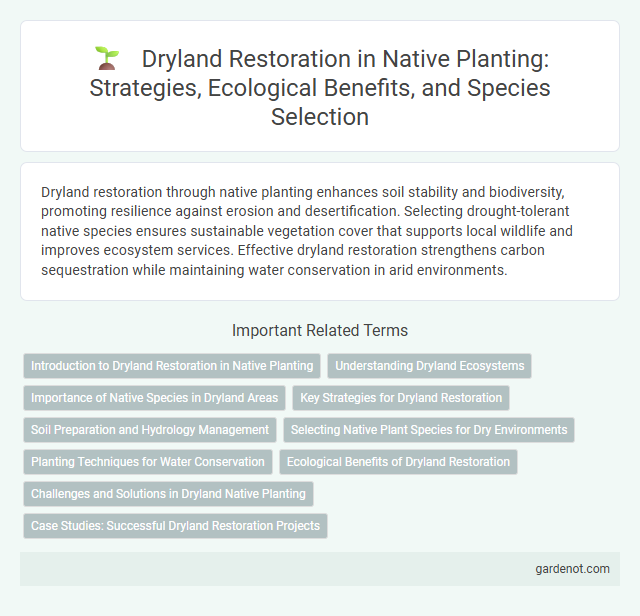Dryland restoration through native planting enhances soil stability and biodiversity, promoting resilience against erosion and desertification. Selecting drought-tolerant native species ensures sustainable vegetation cover that supports local wildlife and improves ecosystem services. Effective dryland restoration strengthens carbon sequestration while maintaining water conservation in arid environments.
Introduction to Dryland Restoration in Native Planting
Dryland restoration in native planting focuses on rehabilitating arid and semi-arid ecosystems by reintroducing indigenous plant species adapted to low rainfall and extreme temperatures. This restoration enhances soil stability, prevents erosion, and supports biodiversity by promoting native flora that can survive harsh dryland conditions. Effective dryland restoration requires selecting drought-tolerant species with deep root systems to improve soil moisture retention and ecosystem resilience.
Understanding Dryland Ecosystems
Dryland ecosystems cover approximately 41% of the Earth's land surface and support over 2 billion people globally. These areas are characterized by low rainfall, high evaporation rates, and fragile soils prone to erosion and degradation. Understanding the native plant species and their adaptations to drought, poor soils, and temperature extremes is crucial for successful dryland restoration and ecosystem resilience.
Importance of Native Species in Dryland Areas
Native species play a crucial role in dryland restoration by enhancing soil stability and reducing erosion through their deep root systems adapted to arid conditions. These plants improve water retention and promote biodiversity, supporting a resilient ecosystem capable of withstanding drought and climate variability. Integrating native species in dryland restoration projects ensures sustainable habitat regeneration and long-term ecological balance.
Key Strategies for Dryland Restoration
Key strategies for dryland restoration include selecting drought-tolerant native plant species that improve soil stability and enhance water retention. Implementing soil amendments such as organic mulches and biochar boosts moisture conservation and nutrient availability in arid environments. Restoration efforts also emphasize erosion control techniques and the reestablishment of native vegetation to restore ecosystem function and biodiversity.
Soil Preparation and Hydrology Management
Effective dryland restoration relies on precise soil preparation techniques such as deep ripping and organic mulch application to enhance soil structure and moisture retention. Hydrology management practices including contour swales and micro-catchments optimize water infiltration and reduce runoff, promoting native plant establishment. Integrating these methods accelerates ecosystem recovery by maintaining soil moisture critical for drought-resilient native species in arid environments.
Selecting Native Plant Species for Dry Environments
Selecting native plant species such as Artemisia tridentata, Bouteloua gracilis, and Encelia californica enhances dryland restoration by improving soil stability and water retention. These drought-tolerant plants are adapted to low precipitation and high temperatures, promoting ecosystem resilience and biodiversity. Incorporating native grasses, shrubs, and succulents supports efficient nutrient cycling and habitat restoration in arid landscapes.
Planting Techniques for Water Conservation
Dryland restoration emphasizes planting techniques that maximize water conservation through soil moisture retention and reduced evaporation. Methods such as deep hole planting, mulch application, and the use of native drought-resistant species promote root establishment and enhance water infiltration. Implementing contour planting and micro-catchments further directs and conserves scarce rainfall for optimal plant growth in arid environments.
Ecological Benefits of Dryland Restoration
Dryland restoration enhances soil fertility and increases water retention, promoting sustainable ecosystems that support native plant biodiversity. Restoring native vegetation reduces erosion, stabilizes microclimates, and creates habitats for pollinators and wildlife species adapted to arid environments. These ecological improvements contribute to carbon sequestration and resilience against desertification, benefiting overall ecosystem services.
Challenges and Solutions in Dryland Native Planting
Dryland restoration faces challenges such as water scarcity, soil erosion, and extreme temperatures that hinder native plant growth. Implementing drought-resistant native species and employing water conservation techniques like mulching and rainwater harvesting significantly improve plant survival rates. Soil amendment with organic matter and protection against grazing also enhance restoration success in arid environments.
Case Studies: Successful Dryland Restoration Projects
Successful dryland restoration projects, such as the Loess Plateau in China and Niger's Farmer Managed Natural Regeneration (FMNR), demonstrate effective native planting techniques that improve soil fertility, increase vegetation cover, and enhance water retention. These case studies highlight the use of drought-resistant native species like Acacia and Prosopis, which stabilize the soil and restore ecosystem functions. Long-term monitoring reveals significant increases in biodiversity and local livelihoods, confirming the critical role of native plants in sustainable dryland restoration.
Dryland restoration Infographic

 gardenot.com
gardenot.com